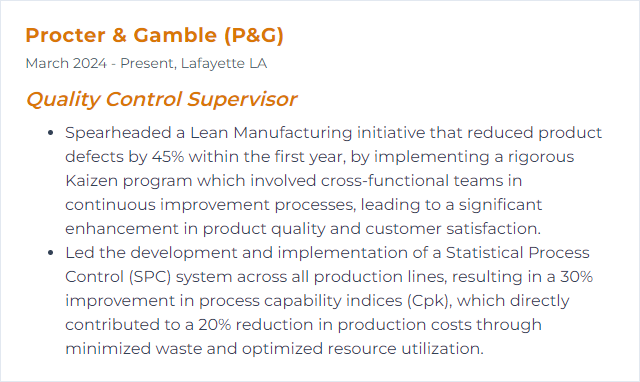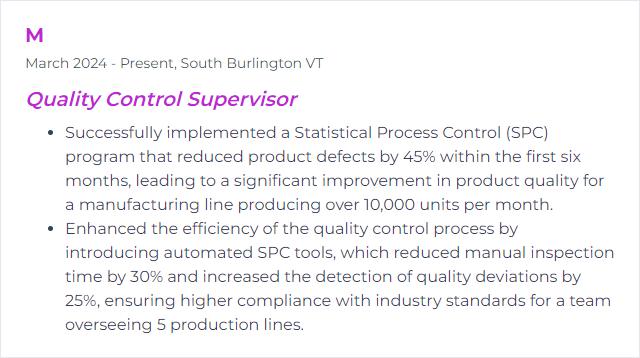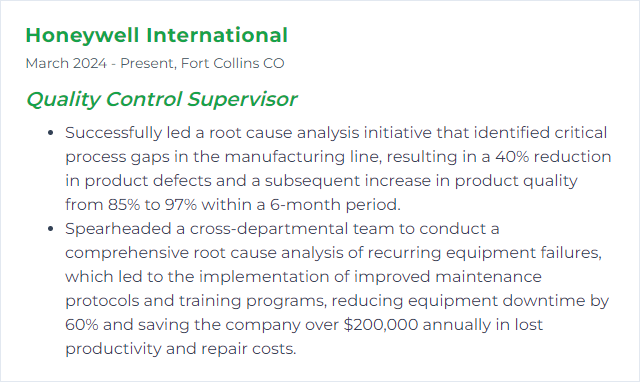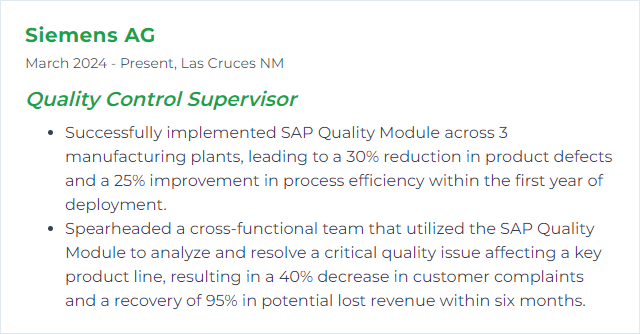Top 12 Quality Control Supervisor Skills to Put on Your Resume
In the competitive landscape of quality control management, a broad, credible skill set cuts through the noise. Below you’ll find the top 12 quality control supervisor skills that, when showcased well on a resume, can sharpen your candidacy and signal that you can uphold, improve, and scale quality standards across an operation.
Quality Control Supervisor Skills
- ISO 9001
- Six Sigma
- Lean Manufacturing
- Statistical Process Control (SPC)
- Quality Management Systems (QMS)
- Root Cause Analysis
- CAPA (Corrective and Preventive Action)
- GMP (Good Manufacturing Practices)
- SAP Quality Module
- Minitab
- FMEA (Failure Mode and Effects Analysis)
- Auditing Standards
1. ISO 9001
ISO 9001 is the globally recognized standard for establishing, maintaining, and improving a quality management system (QMS). Organizations use it to demonstrate consistent delivery of products and services that meet customer and regulatory requirements. For a Quality Control Supervisor, it frames daily discipline: process control, risk-based thinking, corrective action, and relentless improvement.
Why It's Important
It enforces a unified framework for quality processes, aligning teams on policy, objectives, and metrics. That clarity drives consistent outputs, fewer surprises, and happier customers—along with better compliance.
How to Improve ISO 9001 Skills
Focus on what actually moves the needle:
Engage and Train Team: Make standards meaningful. Short, frequent training. Clear ownership. Reinforce with job aids and floor coaching.
Strengthen Internal Audits: Audit for effectiveness, not just compliance. Prioritize high-risk processes. Track findings to closure with dates, owners, and evidence.
Harvest Customer Feedback: Build a clean loop. Collect, analyze for themes, act, and verify impact. Close the loop visibly.
Apply Risk-Based Thinking: Use simple risk registers and heat maps. Anticipate failure points; mitigate early.
Lean on PDCA: Plan-Do-Check-Act in short cycles. Small experiments beat big assumptions.
Use Quality Tools: Six Sigma, Kaizen, 5S, visual controls. Keep it practical and data-backed.
Develop Suppliers: Qualification, periodic reviews, shared KPIs. Audit when risk or performance signals demand it.
Digitize Wisely: Document control, CAPA tracking, audit workflows. Reduce manual churn and errors.
Measure What Matters: A handful of tight KPIs—nonconformities, first-pass yield, on-time CAPA closure, complaint rate.
Secure Leadership Commitment: Regular management reviews with real decisions, not just reports.
How to Display ISO 9001 Skills on Your Resume

2. Six Sigma
Six Sigma is a data-first methodology that shrinks variation, eliminates defects, and stabilizes processes. A Quality Control Supervisor leans on DMAIC, crisp problem statements, and hard evidence to drive results.
Why It's Important
Because variation is the silent saboteur. Six Sigma corrals it, improving reliability, reducing scrap, and lifting customer confidence while saving serious cost.
How to Improve Six Sigma Skills
Keep Learning: Refresh tools and tactics regularly (hypothesis tests, control plans, capability analysis). Certifications help, but hands-on projects teach faster.
Run DMAIC with Discipline: Define clearly, measure cleanly, analyze ruthlessly, improve iteratively, control visibly. Don’t skip gates.
Use the Right Software: Standardize on tools for stats, visualization, and dashboards. Minitab is common; spreadsheets and BI tools can complement.
Build a CI Culture: Train team leads on waste hunting and quick wins. Reward ideas that stick.
Review Projects Often: Health checks, tollgates, and KPI ties keep efforts aligned with business outcomes.
Cross-Functional by Default: Pull in production, maintenance, supply chain, and quality—problems rarely live in one silo.
How to Display Six Sigma Skills on Your Resume

3. Lean Manufacturing
Lean Manufacturing trims waste and accelerates flow while protecting quality. It’s not a toolkit; it’s a habit—seeing problems early, fixing them fast, keeping them gone.
Why It's Important
Less waste, smoother processes, higher first-pass yield. Customers get what they want, when they want it, without drama. Costs drop. Morale climbs.
How to Improve Lean Manufacturing Skills
Map Value Streams: Visualize end-to-end flow. Spot bottlenecks, delays, rework loops. Then attack the worst first.
Run 5S: Sort, set in order, shine, standardize, sustain. Workplace clarity prevents mistakes before they hatch.
Build Quality at the Source: Jidoka, clear stop-the-line rules, andon signals. Don’t pass defects downstream.
Kaizen Mindset: Frequent, small, staff-led improvements. Celebrate fixes, however humble.
Pull Systems: Kanban and right-sized WIP. Flow beats push every day of the week.
Root Cause Every Time: 5 Whys and fishbone diagrams. Symptoms are noisy; causes are quiet—hunt the quiet.
Standard Work: Document best-known methods, make them visible, keep them current. Train to standard; improve the standard.
How to Display Lean Manufacturing Skills on Your Resume

4. Statistical Process Control (SPC)
SPC uses statistics to monitor, control, and improve processes in real time. Control charts, capability studies, and signals that separate noise from action—so you intervene before defects spread.
Why It's Important
It sustains stable processes and squeezes variation, cutting scrap and escapes. Predictability is power.
How to Improve Statistical Process Control (SPC) Skills
Train the Front Line: Teach chart types, rules, and reactions. If operators can read the chart, they can protect the process.
Real-Time Monitoring: Use SPC software or dashboards to catch trends early. Alerts should be quick, clear, and actionable.
Standardize Data Collection: Sampling plans, measurement methods, calibration. Garbage in, garbage conclusions.
Analyze Routinely: Weekly reviews of charts, shifts, trends. Use tools like Minitab or R for deeper dives.
Elevate the Culture: Treat special-cause signals like a fire alarm. Move fast, then prevent the next one.
Go Beyond Basics: Capability indices, short-run SPC, DOE when complexity rises. Broaden the toolkit.
Include Suppliers: Share specs, methods, and charts. Quality upstream = calm downstream.
Improve the System: Regularly refine sampling, charting choices, and reactions based on learning.
How to Display Statistical Process Control (SPC) Skills on Your Resume

5. Quality Management Systems (QMS)
A QMS is the backbone: policies, procedures, processes, and records that ensure products and services consistently meet expectations. It channels continuous improvement and keeps regulatory and customer commitments tight.
Why It's Important
It reduces chaos, standardizes excellence, and shines light on problems before they grow teeth. For supervisors, it’s how daily actions map to strategic quality goals.
How to Improve Quality Management Systems (QMS) Skills
Map What You Do: Document processes as they are, not as you wish they were. Then tune them for clarity and flow.
Involve Everyone: Role-based training, quick reference guides, and visible process ownership.
Adopt the Right Tech: Document control, change management, CAPA, training matrices—integrated and auditable.
Set SMART Goals: Few, sharp targets tied to defects, cycle time, escapes, customer sentiment.
Build CI into the Rhythm: Kaizen events, A3s, and after-action reviews. Make improvement habitual.
Track KPIs: Review monthly. Act weekly. Visualize daily.
Stay Current with Standards: Monitor updates to ISO requirements and industry regulations; adjust procedures promptly.
Close the Customer Loop: Intake, triage, action, verification. Feedback that sticks.
Manage Risk: Integrate risk assessment into planning and change control. No blind spots.
Benchmark: Learn from peers and industry leaders. Borrow good ideas shamelessly.
How to Display Quality Management Systems (QMS) Skills on Your Resume

6. Root Cause Analysis
Root Cause Analysis (RCA) is a structured way to find the underlying causes of defects or failures and make them stop—permanently.
Why It's Important
Fixing symptoms is a treadmill. RCA breaks the loop, preventing recurrence and strengthening the process long term.
How to Improve Root Cause Analysis Skills
Define the Problem: Specific, measurable, time-bound. Include where it appears and where it doesn’t.
Collect Evidence: Process maps, data cuts, photos, operator notes. Facts over hunches.
Use the Tools: 5 Whys, fishbone (Ishikawa), fault tree, Pareto. Pick the tool that fits the mess.
Isolate Causes: Look for converging patterns. Verify with tests or trials.
Implement Corrective Actions: Engineering and procedural changes, mistake-proofing, training updates.
Verify Effectiveness: Monitor post-change metrics; add controls if drift reappears.
Document and Share: Clear write-ups turn one fix into many future saves.
How to Display Root Cause Analysis Skills on Your Resume

7. CAPA (Corrective and Preventive Action)
CAPA is the engine that turns problems into durable fixes and safeguards. Corrective actions resolve current issues; preventive actions block future ones.
Why It's Important
It eliminates repeat failures, shores up compliance, and demonstrates due diligence to regulators and customers alike.
How to Improve CAPA (Corrective and Preventive Action) Skills
Clarify the Issue: Tight problem statements and risk grading. No ambiguity.
Do Robust RCA: 5 Whys, fishbone, evidence-backed. Don’t accept the first plausible cause.
Action Planning: Separate quick containment from long-term fixes. Owners, deadlines, resources.
Execute and Track: Visual boards or digital trackers. Status transparent to all stakeholders.
Train and Communicate: Update SOPs, retrain roles, broadcast changes clearly.
Measure Effectiveness: Define success criteria up front. Verify with data over time.
Comply with Standards: Align with ISO 9001 and, where applicable, FDA/EMA expectations. Keep documentation audit-ready.
How to Display CAPA (Corrective and Preventive Action) Skills on Your Resume

8. GMP (Good Manufacturing Practices)
GMP are the rules of the road for making safe, consistent products. They span people, premises, processes, and records—end to end.
Why It's Important
Because quality cannot be tested into a product at the finish line. GMP builds it in at every step, satisfying regulators and protecting patients or customers.
How to Improve GMP (Good Manufacturing Practices) Skills
Track Regulations: Keep current with FDA, EMA, and local authority updates. Translate changes into SOP revisions fast.
Train Continuously: Short, scenario-based refreshers. Role-specific. Verified comprehension.
Tighten Documentation: ALCOA+ principles (Attributable, Legible, Contemporaneous, Original, Accurate, plus completeness and consistency). Audit your records often.
Audit Regularly: Risk-based internal audits with strong root cause follow-up. Supplier audits where exposure is high.
Optimize QC: Right-first-time sampling, validated methods, change control discipline.
Culture of Quality: Empower stop-the-line behavior. Recognize good catches.
Enable with Tech: eQMS, electronic batch records, validated systems. Reduce manual entry and transcription errors.
How to Display GMP (Good Manufacturing Practices) Skills on Your Resume

9. SAP Quality Module
The SAP Quality Management (QM) module connects quality planning, inspection, and control with procurement, production, and sales. One system of record, many decisions made sharper, faster.
Why It's Important
It automates checks, standardizes inspections, and links nonconformances to actions. Less swivel-chair work; more confidence in the data.
How to Improve SAP Quality Module Skills
Master Core Functions: Inspection plans, lots, results recording, usage decisions, notifications, and quality info records.
Customize Thoughtfully: Tailor catalogs, codes, and workflows to mirror how you operate—then prune complexity.
Automate Routine Tasks: Templates, default values, and integrations reduce manual entry and misses.
Integrate Broadly: Link QM with MM, PP, and SD. Quality should ride along every movement of material.
Train Users by Role: Inspectors, planners, supervisors—each needs a focused path and sandbox practice.
Use Analytics: Build dashboards on defect trends, vendor quality, and cost of poor quality. Act on the patterns.
Stay Updated: Apply patches and keep an eye on new features. Small upgrades can unlock big wins.
Collect Feedback: Hold periodic user councils. Fix friction points quickly.
How to Display SAP Quality Module Skills on Your Resume

10. Minitab
Minitab is a statistics workhorse for quality pros—control charts, capability, regression, DOE, and more—packed into a user-friendly interface.
Why It's Important
It turns raw data into crisp, defensible decisions. Faster insights, fewer guesses.
How to Improve Minitab Skills
Take Structured Training: Cover essentials (distributions, tests, charts) and advanced topics (DOE, ANOVA, reliability).
Practice on Real Data: Use your shop’s numbers. Messy data teaches the most.
Build Templates: Standardize control plans, capability reports, and visualizations for repeatability.
Join Communities: User groups and forums surface tricks, pitfalls, and creative solutions.
Stay Current: Explore new features and case studies; keep your toolbox sharp.
How to Display Minitab Skills on Your Resume

11. FMEA (Failure Mode and Effects Analysis)
FMEA systematically identifies how a product or process can fail, why it might happen, and what the fallout could be—then prioritizes what to fix first.
Why It's Important
It’s proactive risk control. When done well, it prevents defects, boosts reliability, and saves cost before it’s ever spent.
How to Improve FMEA (Failure Mode and Effects Analysis) Skills
Train a Cross-Functional Team: Design, manufacturing, quality, maintenance, even suppliers. Wider lens, fewer blind spots.
Follow Current Guidance: Use the AIAG & VDA approach where applicable, including Action Priority for smarter focus.
Anchor in Data: Feed in field returns, warranty claims, SPC signals, audit findings. Reality beats speculation.
Prioritize Risks: Apply AP or refined RPN logic. Aim actions at high-severity and detectability gaps.
Integrate with QMS: Link FMEAs to control plans, work instructions, and CAPAs. Keep them alive during change control.
Review Regularly: Refresh after design or process changes, new suppliers, or incident learnings.
Communicate Outcomes: Make actions visible, owners accountable, and results measurable.
How to Display FMEA (Failure Mode and Effects Analysis) Skills on Your Resume

12. Auditing Standards
Auditing standards for quality (such as ISO 19011 guidance for auditing management systems and industry-specific schemes like IATF 16949 or GxP expectations) define how to plan, conduct, report, and follow up on audits so findings are reliable and improvements stick.
Why It's Important
Standardized audits produce consistent evidence, strong corrective actions, and credible assurance to leadership, customers, and regulators. They turn “we think” into “we know.”
How to Improve Auditing Standards Skills
Invest in Auditor Competence: Train on ISO 19011 principles, interviewing, sampling, and evidence evaluation. Shadowing and calibration sessions keep judgments aligned.
Use Risk-Based Audit Plans: Focus on high-severity processes, past nonconformities, changes, and supplier risks.
Leverage Technology: Digital checklists, mobile evidence capture, and dashboards for trend analysis. Less paper, more insight.
Strengthen QA of Audits: Peer reviews of reports, periodic performance checks of auditors, and closure verification of actions.
Encourage Transparency: Psychological safety during audits uncovers the truth faster. Reward candor, not perfection.
Benchmark and Improve: Compare audit programs against industry peers, update protocols, and measure audit effectiveness—not just completion.
How to Display Auditing Standards Skills on Your Resume

